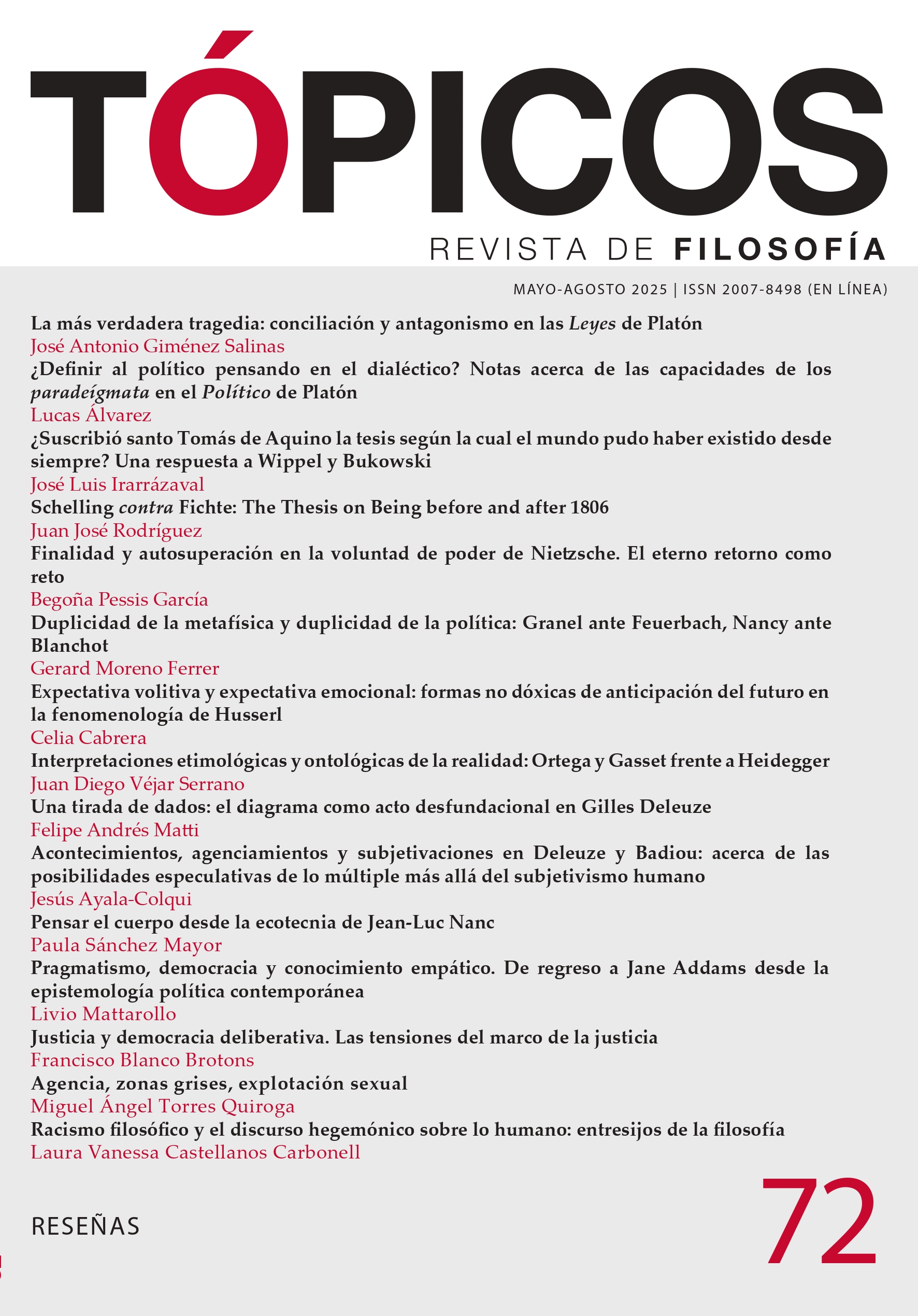Published 2025-04-29
Keywords
- Deleuze,
- diagram,
- ungrounding,
- event,
- figure
Copyright (c) 2025 Tópicos, Revista de Filosofía

This work is licensed under a Creative Commons Attribution-NonCommercial-NoDerivatives 4.0 International License.
How to Cite
Abstract
This article analyzes the diagrammatic operation as ungrounding. It is argued that the diagrammatic act is the refoundation of the becoming of Being. The formulation of the roll of the dice is of particular interest, since in this way Deleuze describes the diagram as the process that brings forces together at the same time as it ungrounds the current structures of Being. In this way, all events are only possible insofar as there is a specific action that removes everything that already exists and allows for the possibility of a new reconfiguration of the temporal and spatial order that would frame this new individual. Thus, in this article the two main facets of the diagram converge: the diagram as a capture of forces and arrangement of dispersed multiplicities and as an act of removal that makes it possible for the Self to become actualized.
References
- Badiou, A. (2011). Deleuze: el clamor del ser. D. Scavino (trad.). Manantial.
- Batt, N. (2004). L’expérience diagrammatique : un nouveau régime de pensée. Théorie, Littérature, Epistémologie, 22, 5-28.
- Bisso, E. (2013). Lacan con Deleuze: lógicas del sentido. Revista Affectio Societatis, 10(18), 2-16. https://doi.org/10.17533/udea.affs.15593
- Bogue, R. (2003). Deleuze on Music, Painting and the Arts. Routledge. https://doi.org/10.4324/9780203826065
- Bouillon, A. (2016). Deleuze et Antonin Artaud : l’impossibilité de penser. L’Harmattan.
- Buydens, M. (2005). Sahara : l’esthétique de Gilles Deleuze. Vrin.
- De Landa, M. (2000). Deleuze, Diagrams and the Genesis of Form. American Studies, 45(1), 33-41.
- Deleuze, G. (1996a). Diálogos. J. Vázquez(trad.). Pre-Textos.
- Deleuze, G. (1996b). Lógica del sentido. M. Morey (trad.). Paidós.
- Deleuze, G. (1998a). El pliegue. J. Vázquez y U. Larraceleta (trads.). Paidós.
- Deleuze, G. (1998b). Nietzsche y la filosofía. C. Artal (trad.). Paidós.
- Deleuze, G. (2002). Francis Bacon : Logique de la sensation. Éditions de Minuit.
- Deleuze, G. (2015a). Foucault. J. Vázquez Pérez (trad.). Paidós.
- Deleuze, G. (2015b). Kant y el tiempo. Equipo Editorial Cactus (trad.). Cactus.
- Deleuze, G. (2016). Crítica y clínica. T. Kauf (trad.). Anagrama.
- Deleuze, G. (2017). Diferencia y repetición. M. S. Delpy y H. Beccacece (trads.). Amorrortu.
- Deleuze, G. (2020). La subjetivación: curso sobre Foucault. P. Ires y S. Puente (trads.). Cactus.
- Deleuze, G. (2021). El poder: curso sobre Foucault. P. Ires y S. Puente (trads.). Cactus.
- Deleuze, G. y Guattari, F. (1985). El anti-Edipo. F. Monge (trad.). Pre-Textos.
- Deleuze, G. y Guattari, F. (2002). Mil mesetas. J. Vázquez y U. Larraceleta (trads.). Pre-Textos.
- Deleuze, G. y Guattari, F. (2019). ¿Qué es la filosofía? T. Kauf (trad.). Anagrama.
- Foucault, M. (2002). La arqueología del saber. A. Garzón del Camino (trad.). Siglo XXI.
- Foucault, M. (2008). Vigilar y castigar. A. Garzón del Camino (trad.). Siglo XXI.
- Garo, I. y Sauvagnargues, A. (2012). Deleuze, Guattari et Marx. Actuel Marx, 52(2), 11-27. https://doi.org/10.3917/amx.052.0011
- Guattari, F. (2019). Escritos para El anti-Edipo. P. Ires (trad.). Cactus.
- Hasegawa, T. (2020). Le symbolique, une structure plus profonde que la réalité et son apparition. La lecture deleuzienne du structuralisme. Résonances, 11, 17-28. https://resonances.jp/11/le-symbolique-une-structure-plus-profonde-que-la-realite-et-son-apparition/
- Honorato Crespo, P. (2010). Sensación y pintura en Deleuze. Aisthesis, 47, 272-283. https://doi.org/10.4067/S0718-71812010000100019
- Hughes, J. (2008). Deleuze and the Genesis of Representation. Continuum. https://doi.org/10.5040/9781472546272
- Jacob, A. (1969). Sens, énoncé, communication. L’homme et la société, 14, 193-199. https://doi.org/10.3406/homso.1969.1764
- Matti, F. A. (2023). Ver el tiempo: la imagen óptico-sonora pura y su vinculación con el tiempo Aión en Gilles Deleuze. Cuadernos Filosóficos / Segunda Época, 20. https://doi.org/10.35305/cf2.v1i.182
- Matti, F. A. (2024). Literatura menor y sentido: la máquina de expresión como acontecimiento en Gilles Deleuze. Recial, 15(25), 205-226. https://doi.org/10.53971/2718.658x.v15.n25.45631
- Sauvagnargues, A. (2006). Deleuze: del animal al arte. Amorrortu.
- Teyssot, G. (2012). The Diagram as Abstract Machine. V!RUS, 7. http://www.nomads.usp.br/virus/virus07/?sec=3&item=1&lang=en
- Zdebik, J. (2008). Deleuze and the Diagram: Aesthetic Threads in Visual Organization. Continuum.
- Zourabichvili, F. (2011). Deleuze: una filosofía del acontecimiento. I. Agoff (trad.). Amorrortu.





